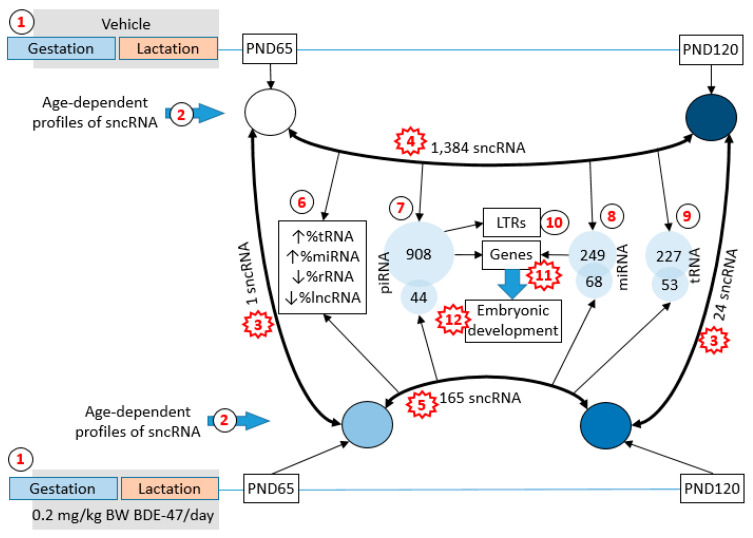Figure 1.
Summary of the study design and main findings. Sperm samples were collected on postnatal day (PND)65 and PND120 from rats perinatally exposed to 2,2′,4,4′-tetrabromodiphenyl ether (BDE-47) or vehicle (1). Profiles of small non-coding RNA (sncRNA) were analyzed in these samples (2). A comparison of sncRNA profiles from exposed and control animals of the same age showed only minor effects of exposure (3). Profiles of sncRNA in control animals of different ages had drastic differences (4). Age-dependent differences were attenuated in exposed animals (5) due to the “convergence” of sncRNA profiles (shown by shades, where the profile of young controls is shown in white, while profile of mature controls is dark blue, and the profiles of both age groups of exposed rats have intermediate shades). Fraction distributions of sncRNA subtypes undergo similar age-dependent changes (shown by arrows) in both exposure groups (6). Age-dependent piRNA (7), miRNA (8) and tRNA (9) were identified for control and exposed animals. Targets of piRNA were enriched for long terminal repeats (LTRs) (10) and protein-coding genes (11). Protein-coding genes—targets of piRNA and miRNA (11)—were enriched with categories related to embryonic development (12). Numbers shown in red stars indicate findings concordant with the analysis of DNA methylation in the same rat model [35]: 3—exposure to BDE-47 had a minor effect on DNA methylation if exposed and control animals of the same age were compared; 4—age-dependent differences in DNA methylation were significant in control animals; 5—these differences were attenuated by BDE-47 exposure due to the “convergence” effect, 11—gene targets of age-dependent sncRNA and genes associate with age-dependent differentially methylated regions of DNA overlapped significantly; 12—these genes were highly enriched for embryonic development.

